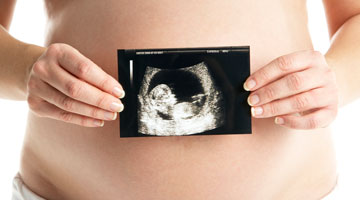malformations, sometimes in the very early stages,” Dr Paul Crane
shares in his video about why ultrasounds are so useful in the first trimester.
Doctors and experts have suggested comprehensive guidelines for scheduling visits with your doctor during pregnancy. For weeks 4 through 28, see your doctor about once a month. Once you get to 28 week, see your doctor twice a month up to 36 weeks. By 36 weeks, see your doctor weekly until you give birth. If you have other pregnancy complications or are older than 35, you will most likely see your doctor more often, depending on the circumstances.
In your first prenatal visit, you can expect to discuss your health history and past pregnancies with your physician, as receiving a complete physical exam and lab work. Most subsequent prenatal visits will include an examination of you and your baby. Your doctor will check your blood pressure, measure weight gain, and check your baby’s heart rate.
Highly acclaimed OBGYN
Jay Goldberg, MD, explains, “The
initial testing is a blood test to determine your blood type, anemia, thyroid, and many other; and then genetic testing, like Cystic Fibrosis and Fragile X, theres a bunch of tests for ethnicities, and then invasive and non-invasive tests. The second trimester is usually a lot less testing. There is a test for women under 35 called the AFP or Triple Marker Testing; and there’s a test called an amino for women over 35, that may be offered by your doctor.”
Besides your regular doctor visits, there are plenty of other ways to keep you and your unborn baby healthy.
DO:
-Take multivitamins or prenatal vitamin with 400-800 micrograms of folic acid every day
-Eat healthy foods such as fruits, vegetables, whole grains, and other unprocessed carbohydrates
-Partake in moderate aerobic activity to keep you up your activity level
-Ask questions about topics that are worrying you
DON’T:
-Stay away from raw fish or other uncooked or unwashed foods
-Don’t drink alcohol, smoke, or use any drugs.
-Avoid x-rays. If necessary, tell your dentist or doctor you are pregnant so extra care is taken.
Prenatal Vitamins
Prenatal vitamins also go along with eating a healthy, full diet. There are many essential vitamins and minerals to take, including Vitamin A, B3, B6, C, D, and folic acid. Minerals such as calcium, iron, magnesium, manganese, phosphorous, potassium, sodium, and zinc can help the baby’s brain and body develop. Essential fatty acids total omega-3, EPA, and DHA build up the fetal brain and retina. Omega 3- fatty acids can help lengthen gestation and prevent perinatal and postpartum depression. Other bioavailable supplements are great for higher rates of absorption efficiency such as: pyridoxal 5’ phosphate (vitamin B6), riboflavin 5’-phosphate (vitamin B2), folinic acid and L-5-MTHF (active forms of folate), and adenosylcobalamin and methylcobalamin (Vitamin B12), and cholecalciferol (Vitamin D3). Some studies suggest the avoidance of D2 (ergocalciferol)
Other key ingredients to avoid include: heavy metals, antimony, arsenic, bismuth, cadmium, lead, silver. Pregnant women should not consume artificial color agents such as Blue 2, Yellow 6, and Red 40, among other types. Furthermore, preservatives like butylated hydroxytoluene and benzoic should be avoided.
The Recommended Dietary Allowance (RDA) represents the amount of nutrients suggested to maintain good health for most people. The Tolerable Upper Intake Levels (UL) designate the highest amount of a certain nutrient that people consume without experiencing potentially harmful side effects. For pregnant women, this is seen most commonly with the intake of iron and calcium. Therefore, expecting mothers should monitor their calcium and iron levels and know the signs .
In general, you cannot overdose on Vitamin D from the sun. In a study published by OBG Management, pregnant women were given doses as high as 200,000 IU in the third trimester of pregnancy to treat vitamin D deficiency. The results shows that there were no signs or symptoms of toxicity in the patients or the newborns, proving that one dose of large amounts of vitamin D can be given to patients. The results also indicated a remaining deficiency of vitamin D, meaning that supplementary doses could be given after the initial dose.
A well balanced diet, exercise, and getting enough sun and fresh air are crucial for the health of the mother and baby. Since pregnant women are taking care of themselves and their growing baby, there are some additional requirements for the nutrition of pregnant women.
Nutrient: Additional Requirement
Calories 300 in second trimester and 400 in third trimester
Protein 60 milligrams, found in: meat, poultry, fish, dried beans, peas, eggs, tofu
Calcium 1200 milligrams, found in: milk, yogurt, cheese, kale, calcium fortified juice
Folic Acid 15 milligrams, found in: leafy green vegetables, enriched cereal, bread, pasta
Iron 30 milligrams, found in: meat, poultry, fish, dried beans, iron-fortified cereal
Skip unsafe foods
Remember to skip any unsafe or possibly harmful foods including:
-Raw seafood (oysters or uncooked sushi)
-Unpasteurized milk (and cheese made from unpasteurized milk)
-Soft cheese (Brie or Camembert)
-Mexican cheese (queso blanco and queso panela)
-Pâté
-Fish with high levels of mercury (swordfish, king mackerel etc.)
Enjoy your pregnancy and look forward to welcoming a new baby into your family. For more information on pregnancy read here: www.kidsinthehouse.com/pregnancy/childbirth/articles Sources:
http://www.womenshealth.gov/publications/our-publications/fact-sheet/prenatal-care.html
http://www.obgmanagement.com/home/article/vitamin-d-and-pregnancy-9-things-you-need-to-know/b8549d223c6dbd0858d547b03a057744.html


































